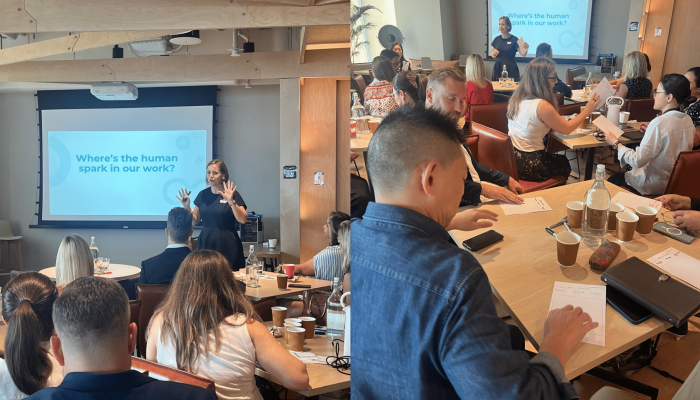He designed the first marketing use of virtual reality in 1993 and as CEO of Fjord, he raised over $10m and pioneered the freemium model for the mobile-dating industry.
So it's to no surprise, we had to invite Mark Curtis, co-founder and Chief Client Officer of Fjord to speak at our Digital Trends dinner in Singapore.
Ahead of the event, we catch up with Mark to talk leading the digital sphere, being a 'Living Brand' and how design and data can work hand in hand.
Why did you launch your company, Fjord?
When I co-founded Fjord in 2001 with Olof Schybergson and Mike Beeston, the dot-com bubble had just burst and many businesses were abandoning digital as a strategy.
Despite the hiccup, the three of us still firmly believed in the transformative power of digital for both business and society as a whole. As a result, we pushed forward with creating a design and innovation consultancy with digital as its native medium.
Going against the grain was a little daunting, but our gut instinct paid off; we were very early to the service design game, and a focus on mobile and human networks in digital has since paid dividends for us and our clients.
How do design and data work hand in hand?
Both data scientists and designers are working towards a common goal of solving a problem, it just so happens they have different tools at their disposable.
At Fjord, it seemed logical for us to combine the two, amplifying the potential to create a much more intelligent solution than could be found by either discipline in isolation. We believe the future of design will be powered by the data collected near constantly by the technology we use and the services we interact with, but you need design to make sense of it.
By applying a design mentality to data capture, we can begin to establish which data is worth collecting and how it can change a product or service in real time. At Fjord, we’ve created a Data + Design practice to capitalise on this thinking for our clients.
How can business leaders encourage design-led thinking within their teams?
In an era of ongoing disruption, many businesses feel they are facing a crisis of innovation and are looking for a solution to future-proof themselves against challengers in their sector.
Simultaneously, evidence is emerging which suggests design-centric companies are outperforming the market average.
Against this backdrop, it’s unsurprising that some view design thinking as the panacea of all their troubles. Unfortunately, the current interpretation of design thinking in the digital age is often shallow and, in that form, not the answer business leaders are looking for.
At Fjord, we advocate for the design rule of three:
- design thinking
- design doing
- design culture
Each element reinforces the others and, when activated together, can help unlock the transformational power of design. For business leaders, the most important first step is being willing to break down siloes and invite co-creation – only then will they be able to tap into the business benefits of design.
You say in your Twitter bio that you’re “interested in all things mobile & digital”, but what’s one app which all marketers need to know about?
There is no such thing.
I’d say the big challenge now is that Amazon’s Alexa and OK Google are threatening the dominance of the OS (operating systems) that have dominated our lives in the smartphone age. Understanding how this will play out is crucial.
You’ve built a reputation as one of the leading practitioners in digital. How can marketers keep up with constantly evolving technologies?
At Fjord, we believe in user-centric design; our ultimate goal is to translate beauty and minimal effort into maximum return.
I’d suggest that marketers apply the same logic to evolving technologies – it’s not about jumping on the latest fad or money-spinner, it’s about asking where technology can be used to give consumers the experience of least friction.
The emergence of voice technology, for example, poses the crucial question to marketers of how to shift a visual brand to an auditory one. Those who succeed in the long term won’t waste time with gimmicks and instead focus their attention on how they can make their brand most accessible to consumers in this new vocal realm, ultimately creating a seamless experience, not just a novel one.
What are Fjord’s main priorities when it comes to marketing strategy?
Elegant Simplicity and a Living Brand.
The former encapsulates our design philosophy:
Reduce complexity to something customers can engage with easily and make it as beautiful as possible.
The latter is about understanding that your brand will – in the digital age – be experienced in places and in combinations with other brands where you have less direct control over its presentation – what do you do about that? And how do you ensure your brand flexes around the customer in real time so it always feels alive – not like a static logo. Lastly, how does it behave?
The more human our digital interaction, the more brands behaviour matters.
What’s the biggest risk you’ve taken in your career?
Selling Fjord to Accenture. It has worked better than we could possibly have imagined.
Which emerging technologies do business leaders need to look out for in 2018?
In Fjord’s 2018 Trends, we identified two emerging technological shifts that could shape the business landscape in the year ahead.
Voice technology will continue to be top of mind for marketing and business leaders alike, with brands having to figure out how they can cut through in a new “third space” where algorithms act as the gatekeepers between brands and consumers.
Perhaps counter-intuitively, the second technological shift in 2018 is digital fading into the background; no longer the centrepiece of brand experience, digital elements will become the invisible enablers of physical experiences.
We have already seen this in action with the launch of Amazon Go, and we expect to see more companies take such an approach in the months ahead.
By Orianna Rosa Royle, digital assistant, The Marketing Society



